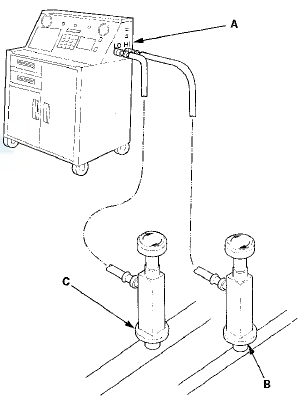 Honda Accord: System Charging
Honda Accord: System Charging
• Air conditioning refrigerant or lubricant vapor can irritate your eyes, nose, or throat.
• Be careful when connecting service equipment.
• Do not breathe refrigerant or vapor.
NOTE: • If accidental system discharge occurs, ventilate the work area before resuming service.
• Additional health and safety information may be obtained from the refrigerant and lubricant manufacturers.
1. Connect an R-134a refrigerant recovery/recycling/charging station (A) to the high-pressure service port (B) and the low-pressure service port (C), as shown, following the equipment manufacturer's instructions.

2. Recover the refrigerant in the A/C system (see page 21-80).
3. Evacuate the system until the suction gauge reads approximately - 9 3 . 3 kPa ( - 7 00 mmHg, -27.6 inHg).
Check that the system holds a vacuum for 15 minutes.
• If the A/C system hold vacuum for 15 minutes, the system does not have a leak. Finish the system evacuation (see page 21-80), then go to step 4.
• If the A/C system does not hold vacuum for 15 minutes, the A/C system has a leak. Find and repair the leak (see page 21-82).
4. Add the same amount of new refrigerant oil to the system that was removed during recovery. Use only DENSO ND-OIL 8 refrigerant oil.
5. Charge the system with the specified amount of R-134a refrigerant. Do not overcharge the system; the A/C compressor will be damaged.
Select the appropriate units of measure for your refrigerant charging station.
Refrigerant Capacity:
400 to 450 g
0.40 to 0.45 kg
0.9 to 1.0 lbs
14.1 to 15 J oz
6. Check for refrigerant leaks (see page 21-82).
7. Check the system performance (see page 21-89).
 System Evacuation
System Evacuation
• Air conditioning refrigerant or lubricant v a p o r c an
irritate your eyes, nose, or throat.
•Be careful when connecting service
equipment.
• Do not breathe refrigerant or v ...
 Refrigerant Leak Check
Refrigerant Leak Check
Special Tools Required
• Leak Detector YGK-H-10PM*
• Leak Detector HLD-100*
• Leak Detector TIFZX-1*
• OPTIMAX Jr. A/C Leak Detection Kit TRP124893*
*Available through the Hon ...
See also:
Brake Booster Test
Functional Test
1. With the ignition switch in LOCK (0), press the brake
pedal several times to deplete the vacuum reservoir,
then press the brake pedal hard and hold it for
15 seconds. If the bra ...
Rear Inner Fender Replacement
NOTE: Take care not to scratch the rear bumper or the
body.
1. Remove the screws, then remove the rear inner
fender (A) from the rear bumper (B) and the body.
2. Install the inner fender in th ...
Remote Transmitter Care
Replacing the Button Battery
If the indicator does not come on when the button is pressed, replace the
battery.
NOTICE
An improperly disposed of battery can damage the
environment. Always confi ...
